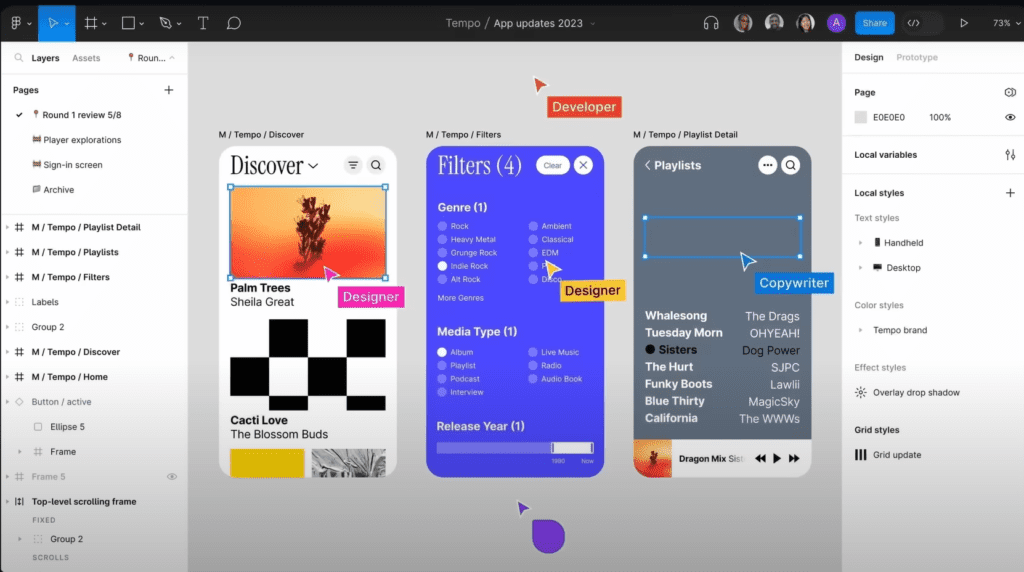Figma Clone Using HTML, CSS, JavaScript and ReactJs With Source Code

Introduction :
This project is a Figma clone, allowing multiple users to collaboratively draw, edit, and manipulate shapes on a canvas in real-time. It leverages Fabric.js for canvas manipulation and Liveblocks for real-time data synchronization between users.
Key Technologies Used:
React.js: This is the main framework we use to build the user interface of our application. React.js helps us create interactive and dynamic web pages.
Fabric.js: This is a powerful JavaScript library that makes working with the HTML5 canvas element easier. Fabric.js helps us draw shapes, add images, and interact with the canvas in a user-friendly way.
Liveblocks: This tool allows multiple users to see changes in real-time. When one user draws a shape or moves an object, everyone else sees the change instantly. Liveblocks ensures that our canvas stays synchronized for all users.
Explanation :
File Structure :
App.tsx
This is the main component where most of the application logic resides.
Initialization and State Management
- Undo and Redo: Using hooks from Liveblocks (
useUndo,useRedo), providing undo and redo functionality. - Canvas Objects Storage: Using
useStoragehook from Liveblocks to store and synchronize canvas objects. - References and State Variables:
canvasRef: Reference to the HTML canvas element.fabricRef: Reference to the Fabric.js canvas instance.- Various refs like
isDrawing,shapeRef,selectedShapeRef, etc., to manage drawing state, selected shapes, and active elements. - State variables for
activeElementandelementAttributes.
Functions and Event Handlers
- Mutations: Using
useMutationto define mutations for deleting and syncing shapes in Liveblocks storage. - Active Element Handler:
handleActiveElementfunction to set the active element in the toolbar and trigger respective actions (e.g., delete, reset, upload image).
UseEffect Hooks
- Canvas Initialization: Initializes Fabric.js canvas, sets up event listeners for mouse actions, object modifications, scaling, and window resize.
- Canvas Rendering: Re-renders the canvas when the Liveblocks storage (
canvasObjects) changes.
Rendering
- Main Layout: Contains
Navbar,LeftSidebar,Live, andRightSidebarcomponents. - Navbar: Handles image uploads and active element selection.
- LeftSidebar: Lists all shapes.
- Live: Displays the canvas.
- RightSidebar: Displays and updates element attributes.
Room.tsx
Sets up the Liveblocks room provider.
- RoomProvider: Initializes the presence and storage for the room.
- ClientSideSuspense: Ensures loading state is handled with a fallback loader.
global.tsx
Contains global styles and Tailwind CSS utilities.
- Global Styles: Basic styles for the application.
- Tailwind CSS Utilities: Custom utilities for various UI components like input fields and right sidebar menu.
layout.tsx
Defines the root layout of the application.
- Metadata: Sets the title and description of the application.
- Google Font: Imports Work Sans font.
- Room Component: Wraps the children components inside the
Roomprovider to enable real-time collaboration.
page.tsx
Disables server-side rendering for the App component to avoid pre-rendering issues with the canvas element.
- Dynamic Import: Uses
dynamicfrom Next.js to importAppwithssr: false.
JavaScript Logic
Main Event Handlers (from @/lib/canvas)
Mouse Events:
handleCanvasMouseDown: Initializes shape creation or selection on mouse down.handleCanvaseMouseMove: Updates the shape being drawn or moved.handleCanvasMouseUp: Finalizes the shape creation or modification.handlePathCreated: Handles creation of paths (freeform drawing).handleCanvasObjectModified: Updates storage when an object is modified.handleCanvasObjectMoving: Handles movement of objects.handleCanvasSelectionCreated: Handles selection of objects.handleCanvasObjectScaling: Handles object scaling.handleCanvasZoom: Manages zoom in and out on the canvas.handleResize: Adjusts canvas size on window resize.
Key Events (from
@/lib/key-events):handleDelete: Deletes selected shape.handleKeyDown: Handles keyboard shortcuts for delete, undo, redo, etc.
Conclusion :
This Figma clone project demonstrates a comprehensive use of React.js for UI, Fabric.js for canvas manipulation, and Liveblocks for real-time collaboration. The code is well-structured, with clear separation of concerns between different functionalities, making it easy to understand and extend. The use of hooks and context ensures a responsive and interactive user experience, while the integration with Liveblocks enables seamless real-time collaboration.
Get Discount on Top Educational Courses
Source Code :
Output :

Find More Projects
URL Shortener Using Python Django Introduction: Long URLs can be shortened into short, shareable links with the help of the URL Shortener …
User Authentication System Using Python Django Introduction: The implementation of safe and adaptable user authentication in Django is the main goal of …
The E-Learning System using Java with a Graphical User Interface (GUI) Introduction The E-Learning System is developed using Java (with a Graphical …
Weather App Using Python Django Introduction: When a user enters the name of a city, the Weather App retrieves current weather information. …
Quiz App Using Python Django Introduction: Users can take quizzes in a variety of subjects, see their results, and monitor their progress …
resume screener in python using python introduction The hiring process often begins with reviewing numerous resumes to filter out the most suitable …








